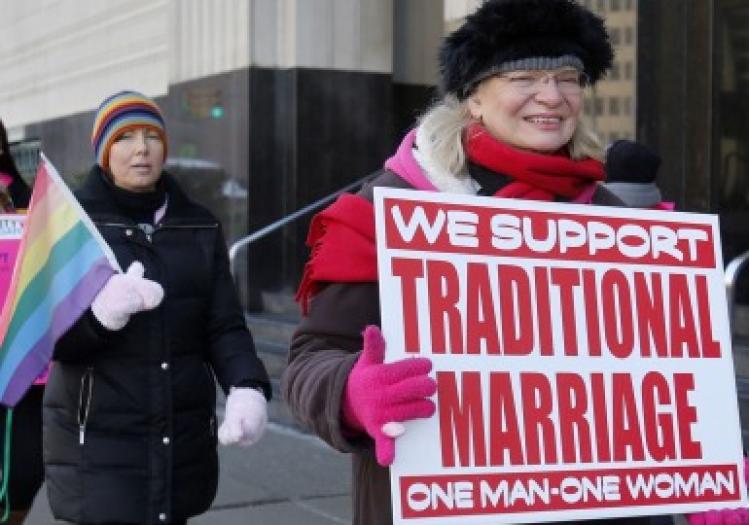
Last summer Commonweal published a controversial essay by Joseph Bottum, “The Things We Share: A Catholic’s Case for Same-Sex Marriage.” Bottum, the former editor of First Things, had long publicly opposed same-sex marriage, but in “The Things We Share” he argued that it was no longer prudent for American Catholics to oppose the legal recognition of same-sex civil marriage—because such opposition had likely become a lost cause; because the only good arguments against same-sex marriage were no longer intelligible in an essentially post-Christian culture; and because same-sex civil marriage might end up being good for gay couples, as well as for America’s marriage culture more generally. According to Bottum, Catholics should instead concentrate their efforts on the “re-enchantment” of a culture that had forgotten “the essential God-hauntedness” of the world. Because he did not argue for a change in church teaching, many readers of Bottum’s essay criticized him for not going far enough. Many conservatives, meanwhile, criticized him for going much too far.
We invited Ross Douthat, a conservative columnist at the New York Times, and Jamie Manson of the National Catholic Reporter to comment on Bottum’s argument. Douthat's piece appears below. Manson's piece is here, and Joseph Bottum's response to both is here.
I share many of the impulses that animate Joseph Bottum’s essay: a recognition that gay-marriage opponents have been thoroughly routed in a remarkably brief span; a frustration with how the debate has played out for the church; a desire to rescue the riches of Catholicism from the clichés and caricatures of culture war. I also share his skepticism about some of the natural-law arguments deployed in defense of traditional marriage, his view that the march toward same-sex wedlock follows logically from premises embraced by the culture long ago, and his emphasis on the metaphysical underpinnings of our present situation.
But for all that, I think his central conclusion is either confused or a cop-out. The logic of Bottum’s argument is similar (as he acknowledges) to the logic of Paul Griffiths’s essay in Commonweal’s pages a decade ago (“Legalize Same-Sex Marriage,” June 28, 2004), which argued that Catholics should support civil marriage for gay couples as a means of disentangling the church’s sacramental view of wedlock from a “profoundly pagan” cultural context, and in the hope of “making the church more seductively beautiful” by contrast with the civil law.
Writing in response to Griffiths, former Commonweal editor Margaret O’Brien Steinfels noted that basic Catholic ideas about wedlock were still widely shared (this was 2004, when 60 percent of the country still favored the traditional definition of marriage), wondered why Griffiths would “throw in the towel in a polity where there is general agreement about the fundamentals of marriage,” and accused him of succumbing to the lure of purity and separatism. “Withdrawal from public debate on the definition of marriage,” she wrote, “or any other publicly contested issue is the gesture of sectarians”—and one that non-despairing Catholics should reject.
Much has changed since then, and Griffiths was obviously prescient about the direction of the debate. But Steinfels was right about the implications of the kind of move he was suggesting. For the Catholic Church to explicitly support the disentanglement of civil and religious marriage, and to cease to make any kind of public argument against treating same-sex unions the same way opposite-sex ones are treated in law and policy, would be a very serious withdrawal from political and cultural engagement. It is one thing to urge the church to prepare for political defeat on this issue—such preparations are obviously necessary, more obviously so now even than when Bottum’s essay first appeared. But it is quite another—more separatist, more sectarian, and thus more problematic—to say that the church should preemptively cease to even make the argument.
After all, gay marriage is not the first case where the arc of modernity has bent away from Catholic ideas about the common good. (The age of social Darwinism springs readily to mind.) And it will not be the last. But to respond to such marginalization by simply withdrawing from the argument is a statement not of prudence but of cultural despair—suited to a social climate so corrupt, so pagan or post-Christian, that political participation is no longer possible at all.
The logic of Bottum’s essay, like that of Griffiths’s before it, points in this direction—toward a strategic withdrawal from a corrupted culture, with implications that extend well beyond the marriage issue. And some of his rhetoric has that flavor as well—for instance, his suggestion that not only the debate over same-sex marriage but engagement across the entire terrain of sexual ethics needs to await the results of a very long-term “re-enchantment” process.
But Bottum doesn’t want to follow this logic all the way to its separatist conclusion. Instead, he insists he’s not actually counseling any kind of political or cultural retreat: “We should not accept without a fight,” he writes, “an essentially un-Catholic retreat from the public square to a lifeboat theology and the small communities of the saved that Alasdair MacIntyre predicted at the end of After Virtue (1981).” But what will the church be doing in the public square, once it has ceased to offer public arguments on questions where its position has become unpopular? Well, says Bottum, we need a “more effective witness in the culture as it actually exists,” and we need to find “much better ways than opposing same-sex marriage for teaching the essential God-hauntedness, the enchantment, of the world.” Fair enough, and I agree—but then, as his examples of that witness and those ways, he offers the following: “Massive investments in charity, the further evangelizing of Asia, a willingness to face martyrdom by preaching in countries where Christians are killed simply because they are Christians, and a church-wide effort to reinvigorate the beauty and the solemnity of the liturgy.”
I am afraid this risks being ridiculous. Charity, missions, martyrdom, liturgy—of course these are all crucial areas of concern for the church, but saying that American Catholics should support missions in Asia as a substitute for arguing about sexuality and marriage in America is a kind of Mrs. Jellyby Catholicism, in which the issues that Providence has actually placed before us are deemed too difficult to wrestle with and in their place we are to turn our gaze to the problems of Christians ten thousand miles away. (Suggesting that we should all go “face martyrdom” is less Jellyby-ish but even more implausible.) A church that followed this advice would be turning inward by turning outward; it would be no less sectarian than the MacIntyrean church that Bottum disfavors, but perhaps more self-deceived.
THE POINT IS this: If Catholics are to continue contending in the American public square, if they are going to choose active participation over catacombs and lifeboats, they need to have something to say to actual Americans about actual American debates. Those debates may have to do with economics, immigration, health care...but in a culture that’s increasingly libertine, atomized, and postfamilial, some of what the church has to say will necessarily have to do with sexuality. And in arguing about sexuality, there is no honest way for the church to avoid stating its position on what the legal definition of marriage ought to be—even in a world where that definition has changed and doesn’t seem likely to change back.
This need not mean starting every conversation with same-sex marriage; once the legal change is accomplished, it may involve talking about the issue less often, or talking about it in some very different way. But it cannot mean pretending that the church’s opposition to calling same-sex unions “marriage” no longer exists.
Unless, of course, it actually doesn’t. Bottum’s essay, as I read it, does not make an argument for a formal change in church teaching, only for ceasing to defend that teaching’s application to secular law. But in some passages he does tiptoe up to an argument that many liberal Catholics would make more explicitly—that is, the idea that there might be not only a small-c conservative case for gay marriage but a specifically Catholic one as well, and that an eventual ecclesiastical blessing of same-sex unions might actually fit in neatly with the church’s broader message on marriage, and help our culture strengthen the crumbling link between sex, monogamy, childrearing, and wedlock.
I hesitate to rebut an argument that’s only gestured at, even if it’s one that many readers favorably disposed to Bottum’s essay would endorse—and one that, if offered, might have lent his essay a little more coherence. So I’ll just say this much: I think a serious look at the trends that have accompanied the advance of gay marriage, at the legal arguments deployed on its behalf, at the shifting understanding of marriage that has made it seem commonsensical, and at the direction of the debate on related issues (from polygamy to surrogacy) should all cast grave doubt on the idea that the church could somehow incorporate same-sex nuptials into its view of marriage without transforming that view beyond all recognition.
And since that wider transformation is something that Bottum definitely does not seek, I’ll conclude where I began: His essay is mostly correct in its diagnosis of why and how the Catholic vision of marriage has lost ground in the culture, but mostly unpersuasive about what kind of engagement the church should seek instead. I don’t blame him; it’s a hard problem to solve. But the preemptive surrender he proposes cannot be the answer.
Please email comments to [email protected] and join the conversation on our Facebook page.
Previous Story
Elsewhere
Next Story
Update: Manson & Douthat respond to Bottum on same-sex marriage


